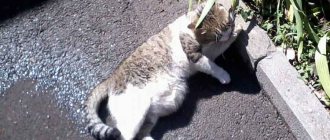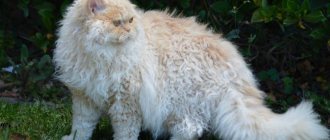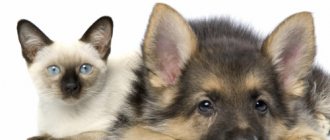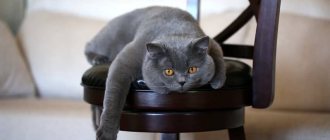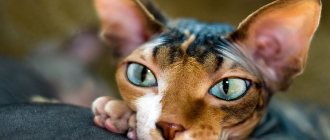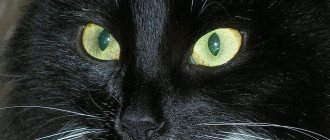A cat with squint is not uncommon, especially among certain breeds. Many owners even like this feature, but how much does this pathology affect the well-being and quality of life of the animal? The disease has several stages of development; in the initial stages it is quite difficult to identify deviations. However, if you suspect that your cat is cross-eyed, you should take her to the vet. If the pathology is congenital, then it will not affect the quality of life of the animal, but if strabismus has developed as a result of injuries or other diseases, the situation should not be left to chance under any circumstances.
Are all Siamese and Thai cats cross-eyed?
Siamese and Thai breeds are prone to this unusual symptom due to the presence of the acromelanism gene in the body. Thanks to him, the animal has an unusually beautiful outfit called color point. It is characterized by the presence of dark-colored limbs and a cream-colored body; the eyes have a rich sky blue color.
Smiling cross-eyed Siamese cat
However, not everything is so wonderful. This gene is also associated with improper development of the optic nerve, which causes the pet to see double images. Advanced forms of pathology can be aggravated by the development of nystagmus - frequent oscillatory movements of the pupil that occur in order to piece together a split picture.
Of course, not all representatives of these breeds suffer from strabismus. The presence of acromellanic coloration is undoubtedly considered a risk factor. A similar pathology can also be detected in Straights, Scottish Folds, Sphynxes and other breeds. The disease can also develop when breeds are crossed incorrectly.
Note! Albino cats are prone to developing strabismus and nystagmus.
Eye diseases in cats
Eye diseases in cats are a large group of diseases. Some of them are inflammatory (infectious), some are non-inflammatory (non-infectious).
Conjunctivitis
The most common inflammatory eye disease in cats.
Causes
May occur due to injuries, allergic reactions, foreign bodies, chemicals, infectious diseases, vitamin deficiencies, etc.
Symptoms
Conjunctivitis is indicated by:
- milky pale film;
- the animal constantly rubs its eye;
- discharge from the eyes.
Treatment
Catarrhal conjunctivitis is treated with aqueous solutions of drops of 0.25% chloramphenicol, 10% sodium sulfacyl instilled into the conjunctival cavity, 2-3 drops 3-4 times a day.
For purulent conjunctivitis in a cat, wash the eyes with a solution of furatsilin (1:5000), solutions of antibiotics, sulfonamides. Use tetracycline, erythromycin and other ointments (place 2-3 times a day in the conjunctival cavity). Intramuscular administration of antibiotics is possible.
Conjunctivitis is a contagious disease. It is necessary to isolate the cat from other pets, and after contact with a sick animal, wash your hands thoroughly.
Injuries
The most common eye pathology is non-infectious. It is especially common in cats that go outside. If a family has several pets, then fights between them are possible.
Causes
- scratches (claws, hard objects);
- falling from a height;
- attack by aggressive relatives and dogs;
- foreign body entering the eye;
- punctures;
- bruises;
- bites;
- lacerations.
Symptoms
- redness of the eyes;
- tearfulness;
- pain syndrome;
- swelling;
- discharge from the eyes.
Treatment
Treatment comes down to antibiotic therapy, anti-inflammatory and painkillers (ointments, eye drops). In difficult cases, surgery may be required.
Entropion and eversion of eyelids
Causes
Turning inward or turning outward of the edges of the eyelids occurs due to injuries, inflammatory processes, burns, and with a reflex spasm in acute conjunctivitis.
Symptoms
- the eyelashes and the edge of the eyelid are turned inward;
- wet eyes;
- severe lacrimation;
- redness of the conjunctiva.
Cat breeds prone to strabismus
Molossians (dogs): breed varieties and overview
There are breeds of cross-eyed cats that are more likely to develop this pathology. It may appear, or it may bypass the pet. A characteristic feature of these breeds is that they all have an acromelanic color. These include Neva Masquerade, Siamese and Thai cats. Also, the risk group includes completely outbred representatives of the species with a color point color.
Important! Pedigree animals with strabismus cannot perform at exhibitions, since this is a fairly significant reason for disqualification. This should be taken into account by people who want to purchase a purebred animal and perform with it at exhibitions, as well as breed it for sale.
Thai cat with squint
Is correction required?
Hereditary strabismus is only an external feature that does not cause any inconvenience to the cat and does not harm it.
It’s another matter if strabismus was acquired in adulthood, then immediate help from a specialist is needed. To accurately diagnose problems with the nervous system and vestibular system, an MRI of the eye orbits or brain may be required.
For various inflammatory diseases, drug treatment is necessary, which is prescribed by a veterinarian. With proper and timely therapy, strabismus in your cat will be completely cured.
If the problem of strabismus is associated with various injuries or damage to the eye muscles, then there is only one way out of the situation - surgical intervention. The operation will have a good outcome only if the disease is detected at an early stage. Otherwise, the animal will face unpleasant consequences for its health and well-being.
That is why it is so important to promptly contact a veterinary clinic as soon as the disease is identified.
The good news is that in the case of strabismus, which is due to a genetic predisposition and does not develop as a result of some disease, the defect is considered cosmetic and does not cause any particular inconvenience to the animal. Moreover, some cat lovers note that cross-eyed cats look very cute, touching and funny, and this defect only gives them individuality.
An example of this is the charming ginger cat Jarvis (Jarvis P. Weasley) from California, adopted from a shelter despite an obvious eye defect, and beloved by his owners and subscribers.
An Internet star named Spangles also squints in one eye. This charming cat from South Carolina has many fans around the world. Spangles' owner, Mary, claims that strabismus does not prevent the cat from living “to the fullest” and posing in extravagant outfits.
What canned food tastes best for cats?
RESEARCH ATTENTION! You and your cat can take part in it! If you live in Moscow or the Moscow region and are ready to regularly observe how and how much your cat eats, and also remember to write it all down, you will receive FREE SET OF WET FOOD.
Project for 3–4 months. Organizer - Petkorm LLC.
Want to participate? Call!
7
Provoking factors of development
Feline strabismus is medically called strabismus. Pathology can be either congenital or acquired. In the latter case, the defect develops against the background of injuries - severe blows to the head or due to falls. Also, a kitten can become cross-eyed after certain diseases:
- developmental pathologies or disturbances in the functioning of the vestibular apparatus (disorientation);
- encephalitis is a viral pathology accompanied by inflammation of brain tissue;
- dysfunction of the central nervous system organs;
- hydrocephalus or dropsy - a disease accompanied by the accumulation of cerebrospinal fluid in the head;
- rabies;
- meningitis - inflammation in the mucous membranes of the brain or spinal cord;
- otitis of the middle or inner ear;
- glaucoma – sudden changes in pressure inside the eye;
- The feline leukemia virus is a disease whose symptoms are very similar to cancer.
A dog whose eyes fall out: a review of breeds
Strabismus sometimes appears due to a hereditary predisposition. If the genetic eye disease is mild, then there is no need for treatment. Oblique cats quickly adapt and are able to lead a full life.
Important! A purebred cross-eyed cat should not be allowed to be bred in the future.
After injury, due to physical impact, the eyeball deviates from its usual, correct position. Diseases that affect muscle tissue can also provoke strabismus. The cause of the shift may be the development of a neoplasm inside the orbit or the occurrence of inflammatory processes.
Problems in the functioning of the vestibular apparatus lead to the fact that the eyeballs can change their location. The fact is that thanks to the vestibular system, a cat can navigate in space. If something doesn’t work correctly, the brain is not able to correctly perceive information about the position of the head, which, in fact, becomes the cause of strabismus.
Clinical picture of rabies in cats
The development of strabismus can also be provoked by a disturbance in the interaction of the organs of the nervous system (CNS) with the organs of vision.
Note! The occurrence of malignant processes in the brain quite often provokes the development of strabismus.
Strabismus in kittens
Strabismus is often observed in small kittens - the eyes of babies under one month of age have a somewhat strange, “glassy” look, and the eyeballs can suddenly move in one direction or the other, which frightens the owner a lot. However, this is not a reason to panic: the kittens’ eye muscles are not yet strong enough, which is why some defocusing is observed. By the age of five months, the strabismus of kittens usually disappears without a trace.
But if this does not happen over time, it is worth visiting a veterinary ophthalmologist to determine the cause. The most common of these is genetic, in which case intervention is not required. However, strabismus that occurs at a later age can be caused by various diseases, including:
- viral infections,
- consequences of injury,
- diseases of the nervous system,
- tumors, including malignant ones,
- dysfunction of the vestibular apparatus, etc.
And in this case, the causes turn out to be much more dangerous than the consequences, that is, strabismus itself, and therefore it is imperative to identify them and begin treatment.
But is there a breed of cat with slanted eyes when strabismus is associated solely with genetic inheritance? Let's figure it out.
Clinical picture and types of strabismus
The acquired disease in animals can develop unilaterally or bilaterally. In the first option, only one eye changes its anatomically correct position, in the second case, respectively, two. Both eyes move in their orbits; several small muscles are responsible for this function. Strabismus occurs when the functioning of these muscle tissues is disrupted and the eyeball is displaced.
1st Choice for cats: Fest Choice food review
In the vast majority of cases, deviations can be detected visually. A clear sign of strabismus is evidenced by asymmetrically located corneas and pupils.
Note! If an animal fixes its gaze on a certain object, but its eyes are fixed differently, then this indicates the presence of pathology.
Representatives of Siamese and Oriental breeds often have pupils close to the nose. This form of pathology is called convergent. If, on the contrary, the pupils are distant from the nose, then this form of the disease is called divergent. The first form is the most common and is often congenital.
Unilateral strabismus in cats
Types of heterotropia in pets
First of all, heterotropia in a pet can be:
- congenital;
- acquired.
The type of illness affects the nature of therapy
If the ocular axes are directed towards the nose, then this type of strabismus will be convergent.
The photo below shows just the converging type of strabismus.
Convergent form of violation
If the eye axes are directed in different directions, then this view is considered divergent.
READ Names for calico cats
If an animal has only one gas, then it is unilateral strabismus. If both eyes are squinting, it is bilateral.
